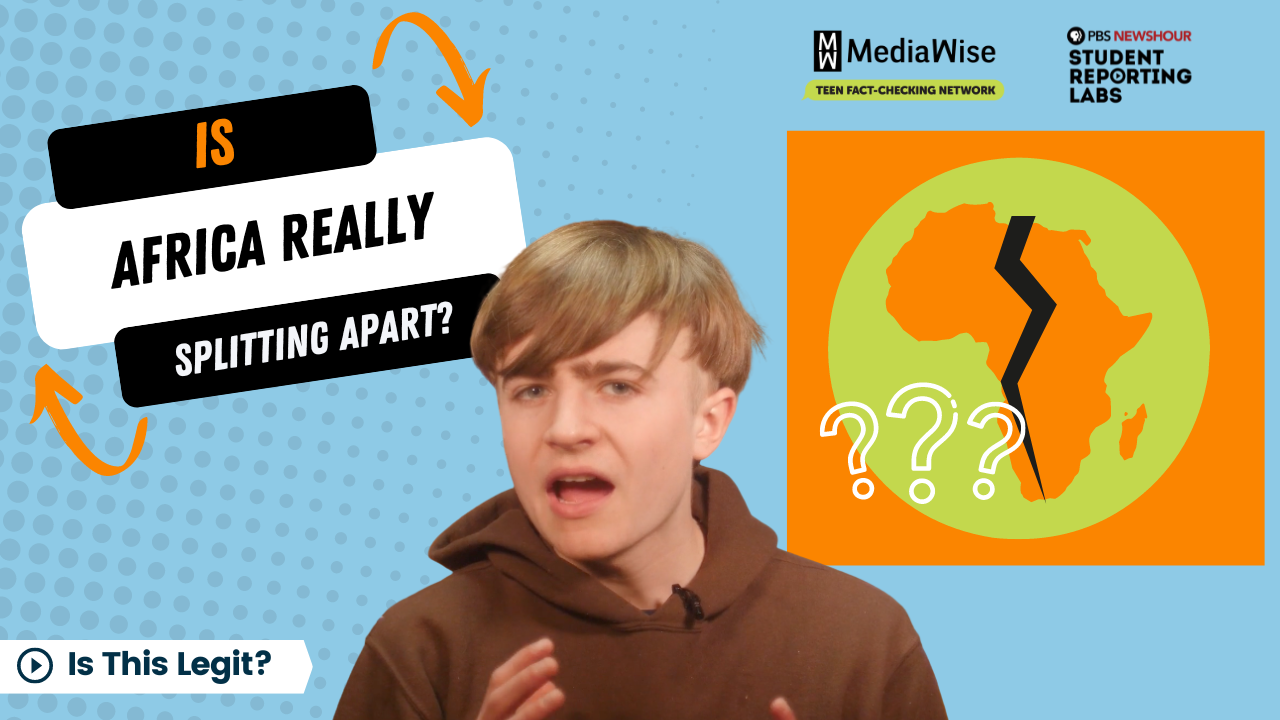This post on TikTok, which says that the continent of Africa is “splitting apart,” caught my attention.
“A massive crack stretching several kilometers made a sudden appearance in Kenya in 2018 and has been gradually growing ever since,” said TikToker Dylan Page.
This guy’s post, which has more than 2 million likes, really grabs your attention, and whenever a social media post brings out a strong emotion like anger, or laughter or — as in this case — disbelief, it’s always best to stop and check it out before sharing.
Let’s begin by asking two questions: What exactly does this guy mean when he says Africa is “splitting apart?” Second, is this really happening at all?
Here’s how I fact-checked it.
Who’s behind the information?
It’s always good to start by answering the question: Who’s behind the information? I used a technique called “lateral reading” and did a keyword search for “Dylan Page.” I opened up a bunch of tabs to figure out who this person is, but there really isn’t a lot of information beyond his TikTok, Instagram and YouTube pages saying he’s a video creator.
I found out that Page claims to be the “#1 news account on TikTok,” but according to searches for “dylan page journalist” or “dylan page news outlet,” he’s not a reporter or associated with any newspaper. Nor was there any mention of an expertise in geology.
Practice click restraint
My next step was to do a keyword search about the topic. I searched for the phrase “Africa splitting apart,” but the top results were from unfamiliar websites. Instead of clicking on the first couple of results, I practiced a media literacy tip called “click restraint” and scrolled further down. Fact-checkers often go through several pages of search engine results to find the information they need. This helps them avoid ads, which are often from unreliable sources.
Further down in the search results are images that purport to be evidence of Africa splitting apart. It’s important to remember that photos like these should never be taken alone as evidence of an event or phenomenon. The images come directly from the internet and we know seeing isn’t always believing online.
If you click on an image, though, you’re able to see where it comes from. The first image I found linked to a USA Today story. According to the article, geologists have known for a while that the African continent could split into two separate parts. When these photos first came out in 2018 showing a large crack in the ground in southwestern Kenya, though, people began worrying about how quickly Africa might split.
The article, however, says that while tectonic plates splitting apart are signs of the continent shifting, the change will take millions of years. So in other words, the continent of Africa is moving apart — but extremely slowly. The article even includes a map that shows what Africa will look like when it splits in two.
Check multiple sources
For good measure, I decided to check what other sources were saying. It’s always best to compare multiple sources when trying to verify information.
According to this story from NBC News, not everyone agrees on what is causing the split. One possibility is that a huge plume of superheated rocks beneath East Africa could be driving it. NBC also explained that evidence of the split comes from a 35-mile-long crack in the Ethiopian desert.
Finally, I looked at one more source, an article from The Guardian by Stephen Hicks, known on Twitter as “seismo_steve.” Again, it’s always important to figure out who is behind the information, so I checked out his Twitter bio, which says that he is a seismologist in the Earth Sciences Department of University College London. That sounds legit!
Hicks has a different perspective. He says that while Africa is indeed splitting apart, not all of the photos we are seeing in these news articles are evidence of the tectonic shifts. Some of the photos that are usually shown as evidence of the continent splitting apart may just be evidence of heavy amounts of rain and erosion.
Our rating
Mostly Legit. We rate this claim as mostly legit because there is clear evidence that Africa is indeed splitting apart, though very, very slowly. Also, some of the photos you see about this online may not really be related to this shift and instead may be the result of erosion.
It’s important to remember that when you come across claims like these to fact-check using reliable sources and not just TikTok videos with content that can be potentially false.
NOTE TO TEACHERS: This article is featured in a free, one-hour lesson plan that teaches students how to find reliable scientific information. The lesson is available through PBS LearningMedia, and includes a lesson summary and a handout, among other resources.






